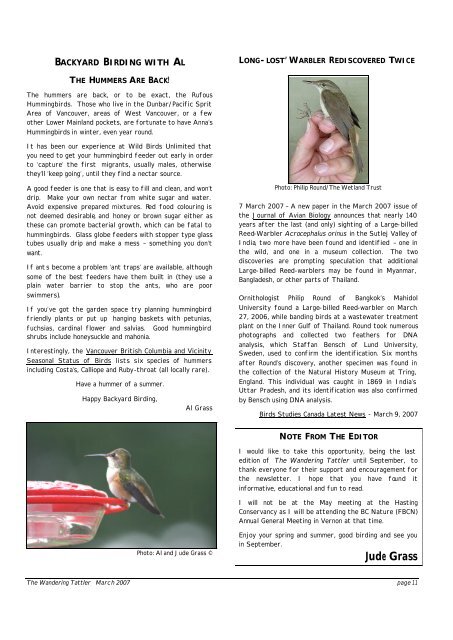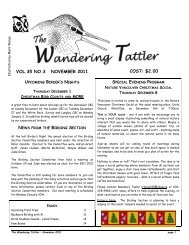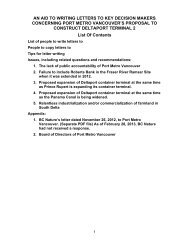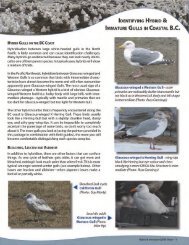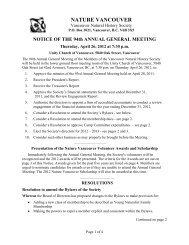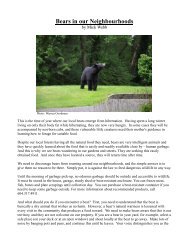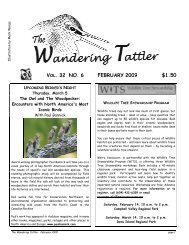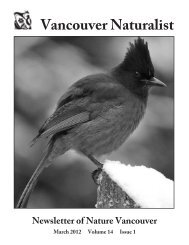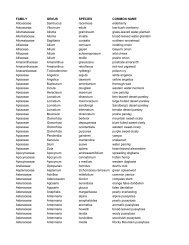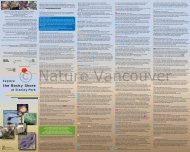Wandering Tattler Apr 07 - Nature Vancouver
Wandering Tattler Apr 07 - Nature Vancouver
Wandering Tattler Apr 07 - Nature Vancouver
Create successful ePaper yourself
Turn your PDF publications into a flip-book with our unique Google optimized e-Paper software.
BACKYARD BIRDING WITH ALLONG-LOST’ WARBLER REDISCOVERED TWICETHE HUMMERS ARE BACK!The hummers are back, or to be exact, the RufousHummingbirds. Those who live in the Dunbar/Pacific SpritArea of <strong>Vancouver</strong>, areas of West <strong>Vancouver</strong>, or a fewother Lower Mainland pockets, are fortunate to have Anna’sHummingbirds in winter, even year round.It has been our experience at Wild Birds Unlimited thatyou need to get your hummingbird feeder out early in orderto ‘capture’ the first migrants, usually males, otherwisethey’ll ‘keep going’, until they find a nectar source.A good feeder is one that is easy to fill and clean, and won’tdrip. Make your own nectar from white sugar and water.Avoid expensive prepared mixtures. Red food colouring isnot deemed desirable, and honey or brown sugar either asthese can promote bacterial growth, which can be fatal tohummingbirds. Glass globe feeders with stopper type glasstubes usually drip and make a mess – something you don’twant.If ant s become a problem ‘ant traps’ are available, althoughsome of the best feeders have them built in (they use aplain water barrier to stop the ants, who are poorswimmers).If you’ve got the garden space try planning hummingbirdfriendly plants or put up hanging baskets with petunias,fuchsias, cardinal flower and salvias. Good hummingbirdshrubs include honeysuckle and mahonia.Interestingly, the <strong>Vancouver</strong> British Columbia and VicinitySeasonal Status of Birds lists six species of hummersincluding Costa’s, Calliope and Ruby-throat (all locally rare).Have a hummer of a summer.Happy Backyard Birding,Al GrassPhoto: Philip Round/The Wetland Trust7 March 20<strong>07</strong> – A new paper in the March 20<strong>07</strong> issue ofthe Journal of Avian Biology announces that nearly 140years after the last (and only) sighting of a Large-billedReed-Warbler Acrocephalus orinus in the Sutlej Valley ofIndia, two more have been found and identified – one inthe wild, and one in a museum collection. The twodiscoveries are prompting speculation that additionalLarge-billed Reed-warblers may be found in Myanmar,Bangladesh, or other parts of Thailand.Ornithologist Philip Round of Bangkok’s MahidolUniversity found a Large-billed Reed-warbler on March27, 2006, while banding birds at a wastewater treatmentplant on the Inner Gulf of Thailand. Round took numerousphotographs and collected two feathers for DNAanalysis, which Staffan Bensch of Lund University,Sweden, used to confirm the identification. Six monthsafter Round’s discovery, another specimen was found inthe collection of the Natural History Museum at Tring,England. This individual was caught in 1869 in India’sUttar Pradesh, and its identification was also confirmedby Bensch using DNA analysis.Birds Studies Canada Latest News - March 9, 20<strong>07</strong>NOTE FROM THE EDITORI would like to take this opportunity, being the lastedition of The <strong>Wandering</strong> <strong>Tattler</strong> until September, tothank everyone for their support and encouragement forthe newsletter. I hope that you have found itinformative, educational and fun to read.I will not be at the May meeting at the HastingConservancy as I will be attending the BC <strong>Nature</strong> (FBCN)Annual General Meeting in Vernon at that time.Photo: Al and Jude Grass ©Enjoy your spring and summer, good birding and see youin September.Jude GrassThe <strong>Wandering</strong> <strong>Tattler</strong> March 20<strong>07</strong> page 11


